Flatland BMX is a riding style in the discipline of BMX. Flatland BMX is one of the less well known riding styles with fewer participants than styles like street and park, though these riders are usually very dedicated. This fact doesn’t mean flatland BMX is a bad riding style or one that isn’t amazing to watch and partake in. I do definitely believe it’s much harder to become proficient in the style of flatland and riders take a lot longer to build up an arsenal of tricks.
Flatland cycling is often described as an artistic form of cycling. A lot more expression and emotion can be shown through the use of tricks when riding this discipline. If you haven’t seen anyone perform a flatland BMX routine before it is a performance of artistic cycling and breakdancing that is done on flat surfaces, usually concrete, and in a place that doesn’t include ramps, jumps or rails.
The difference between flatland frames and other freestyle BMX frames is actually quite significant. The wheelbase is usually much shorter, making pedalling and spinning much easier. The bikes usually have four pegs instead of two and sometimes both front and back brakes too. Freestyle BMX riders need a lot more minute control over themselves and their bikes and using brakes and an extra peg makes is easier and a lot more possible to actually do certain things. Having said this I must say this doesn’t apply to all riders, some people prefer to hone their skills so much that they can do almost every trick without brakes, it all depends on the riders style.
Freecoasters and gyros were two significant parts of a BMX bike designed almost primarily for flatland use. The gyros were needed for the rear brakes when the bars were spun multiple times. The front brake was always fine since the cable could just be threaded through a hollow top cap and all would be fine but the rear brake cable was attached to the bars and the frame. The gyro solution was brilliant and is being used in many different forms on nearly every type of bicycle. The invention of the BMX gyro really progressed the sport of flatland, opening up the possibilities to many new tricks.
The freecoaster was another, more recent invention that helped the sport of flatland a lot. If you haven’t heard of a freecoaster or if you’re not sure as to how they work you should click here to read my other article with an in-depth description as to how all types of bike hub work. The freecoaster hub helped flatland riders do tricks that included rolling the back wheel backwards much easier. It allowed the wheel to be moved in reverse without the hub or cranks engaging, thus letting the rider to freewheel backwards. This was a huge help since riders would always have to turn the cranks backwards along with the movement of the bike, restricting many possible tricks.
Some other main differences between flatland bikes and regular BMX bikes are zero offset handlebars, narrow bars and extremely high-pressure tires. We will explain these in more detail later in this article.
History of Flatland BMX
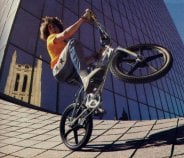
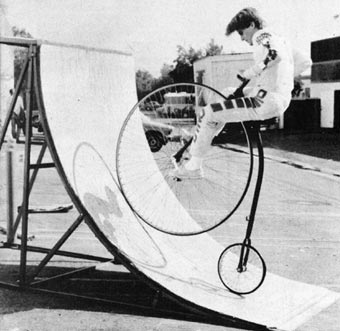
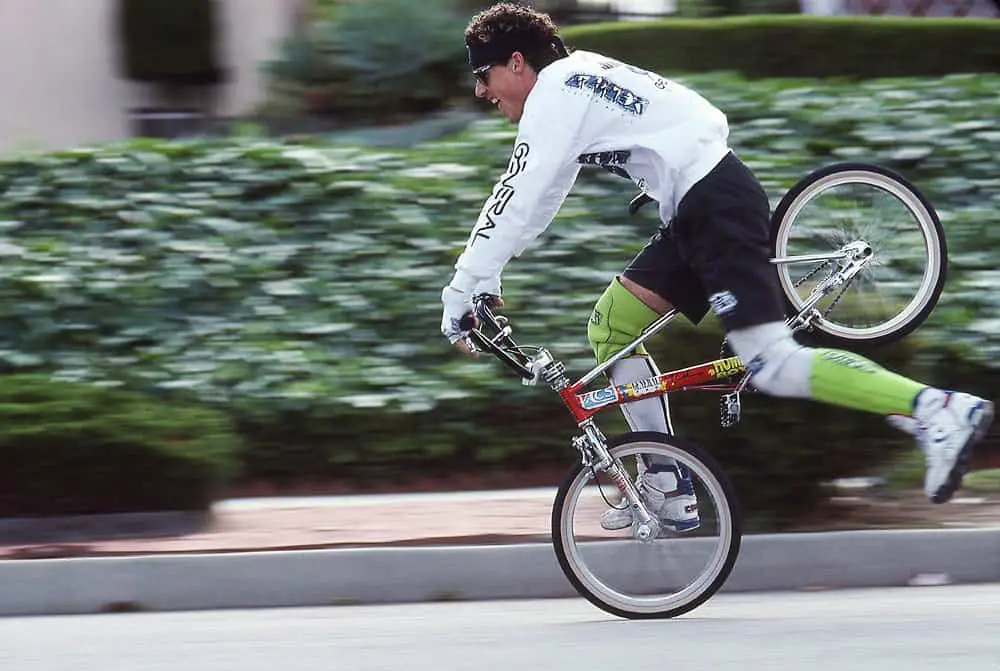
The images above are the three riders recognised as the founding fathers of flatland BMX. From left to right: R. L. Osborn, Bob Haro and Bob Morales.
R. L. Osborne’s father, Bob, was actually the creator of BMX Action magazine and as a result of him starting the first freestyle team with Bob Haro, R. L. Osborne became very interested in this new style of BMX and became very good at flatland BMX, progressing it so much that he became a stunt rider and used endorsements to his advantage, making him the first millionaire within the sport.
Bob Haro is probably the most well-known name on this list. After a successful BMX career, Haro concentrated on art and business. This switch to business is probably the reason most younger BMX riders recognise his name. After a while of riding dirt bikes, Haro got really into racing dirt bikes in California, resulting in him getting a sponsorship riding for Molina’s bike shop.
It was in 1978 that Haro and Osborn teamed up to create the first freestyle BMX team. After three good years of this team, Bob Morales met them both and also joined the team. The three of them progressed their skills and performed shows all over the American Midwest and even into Canada. As a result of these great shows for large, enthusiastic crowds they started getting noticed, even getting Haro in front of Steven Spielberg right around the time he was making E.T. You may see where this is going, but if not, Haro got cast in the biking scene during the movie. This was huge, eventually becoming one of the most well-known films and movie scenes ever made. I definitely remember watching this scene multiple times throughout my childhood.
The E.T gig was a big deal for the team and especially Haro, during the same year he designed the first BMX frame specialising in flatland and freestyle BMX.
Unfortunately, Bob only rode for a few more years before retiring due to recurring knee injuries. I think it’s quite obvious that Haro was one of the man leaders in inventing the flatland BMX scene and the team he rode for. I don’t see it as any surprise that he was inducted into the bicycle hall of fame in 1987.
Finally there’s Bob Morales, he came to the freestyle team around 1977, subsequently meeting R.L Osborn and due to Osborn’s family fame in the sport of BMX, it wasn’t long until he met Bob Haro. Morales became entrepreneurial quite early, at the age of 14 he launched BME (named after himself), which was a small brand that sold BMX stickers and such at local tracks and events.
By the time 1980 came, Haro asked Morales to join the team during a big tour promoting the newly invented flatland and freestyle BMX.
Best Flatland BMX Tricks
Flatland BMX tricks are a lot different to regular types of riding. It’s rare that riders will use obstacles or ramps when performing tricks. Getting good at riding flatland is much harder and usually takes a lot longer than other disciplines. When you look at the difference in tricks and skills it could almost be described as a different sport, in a lot of ways the tricks performed are a lot like trials riding. I see flatland BMX as the most expressive form of cycling. The difference between riders doing the same tricks is outstanding in the discipline of flatland.
I’m going to start describing some of the easier tricks within the sport of flatland. These tricks may seem easy or pointless to work on but I would argue the opposite. Most of these tricks make up the building blocks for some of the hardest and most complicated tricks you can do. An important note is that for near enough all of the tricks in this list include using four pegs. Need to find some great new plastic pegs for your setup? We have a great list on the Top BMX Pegs
The pogo is one that you’ve probably seen if you aren’t very interested in flatland. There are a couple of different ways in which you can get into this trick. When attempting this myself I will either use my foot or my front brake to throw my momentum forward. I will then grip my rear brake, plant my feet on my rear pegs and use the transferring momentum to bring my front wheel up high and up to a good balance point. From this point you can do a lot of different tricks but as you probably guessed, to finish the pogo you have to start hopping on your back wheel. Doing this will make balancing a lot easier. The pogo can also be performed on the front wheel and doing so is quite similar. If you have a front brake then use that along with both your feet on the pegs to get up to a nice balance point and start hopping. If you don’t have a front brake or pegs then you can simply jam your foot in the front wheel and use this as a form of brake to get up to your balance point.
Riding backwards is a very simple but also an important part of flatland BMX. It seems just like a party trick that you can do when you’re bored but it’s actually a very important move to practice as a lot of more advanced tricks will involve riding backwards whilst also being on one wheel. If you’re to start riding backwards from a standstill then it’s simple just to get on the bike the wrong way round and set off but it’s important to know how to get into the backwards riding position after a regular ride. The easiest way is to put both feet on the pegs of one side and then just switch over, sit your bum on your bars and pedal.
The stander is another simple trick. It’s basically just an advancement on riding non-handed. After learning to ride without your hands you can progress onto standing up and using your higher balance point to keep you upright.
The 180° handlebar turn is another good one to practice. To start and make it easier I recommend putting one of your feet on your back peg, one of your hands on the opposite grips and then pull it around fast. It will feel weird riding with your bars this way round but it’s good to get used to it as you can then learn to balance on your front wheel and progress onto tricks that have your rear end in the air or something similar.
Best Flatland BMX Riders & Competition
As you may have guessed from reading other parts of this article, flatland BMX competitions are vastly different to park and street competitions. There are little to no obstacles to use. Riders are expected to use the flat area of concrete provided. The main things judges look for are skill, the ability to maintain coordination, balance and of course raw talent. If you’re struggling to picture a flatland competition, think of sports like figure skating and dancing, it’s a lot like that.
Just like these example sports, riders are judged in a variety of different categories, though some are particularly hard to judge. Firstly, there’s the number of touches the rider makes. If he/she touches the floor throughout their trick then it can be considered an incomplete trick and that floor touch will affect their score detrimentally.
Secondly, there’s the number and difficulty of tricks completed in the allotted time. The best riders have to get skilled at the art of linking tricks together. For example, a breakdancer wouldn’t just stop after one of his dance moves and then move onto doing the next one. The difficulty is also an important one. Unfortunately, when the competition is at a high level it’s hard to rate a trick based on difficulty since there is such a vast range of styles between each rider.
Another important category is the style and flow of the tricks, though this isn’t anything new to flatland, all BMX competition judges look for style and flow.
Finally, there’s showmanship since obviously this is entertainment the rider is judged on how well he works his tricks for the audience and judges. Some riders are very well known for their showmanship and working the crowd to their advantage.
There aren’t nearly as many flatland bike competitions as other types of riding. Unfortunately, this is just because of the fact it is less popular than other riding styles. There are still a variety of competitions around the world that you can go and compete at or watch. For example (as of writing) there’s a big championship event coming up in the UK in March 2023. Click here to see a list of some of the big competitions coming up for the sport of Flatland BMX.
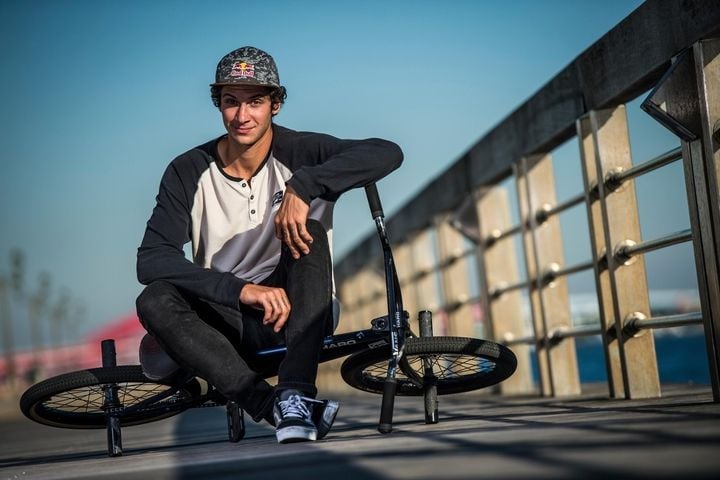
Matthias Dandoi of France is currently one of the best flatland riders in the world, winning his first major competitions when he was 19. Don’t get excited by his young age thinking it’s easy to become an award-winning flatland athlete. Matthias had already spent six solid years riding BMX flatland and street before being crowned the champion.
Dandoi started riding flatland back in 2002 when he spotted another rider at his local skatepark, presumably doing tricks that nobody else even tried. Since then he has been solidly riding, honing his skills and successfully becoming recognised as one of the most inspiring upcoming BMX riders of his generation. Since becoming the world champion and effectively dominating ever since Matthias has started to get into street riding and yes you guessed it, he won some very prestigious competitions in his first few years.
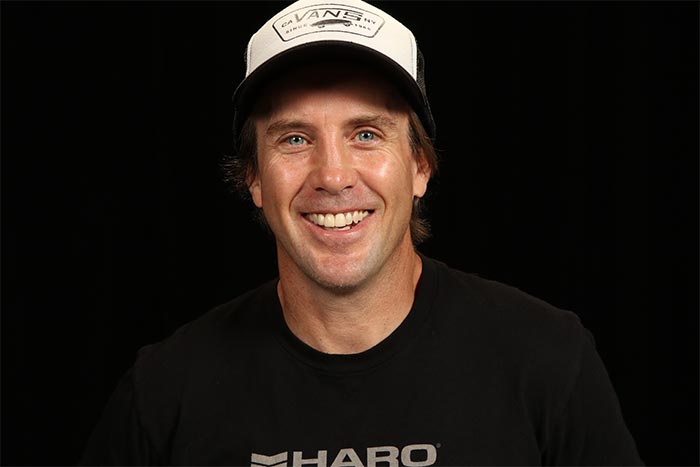
Dennis McCoy is another one of the legendary flatland BMX riders. He is the only rider to ever win titles in Vert, Park and Flatland competitions in the same year. McCoy was a member of the American freestyle association right alongside the greats of Mat Hoffman and Dave Mirra. Along with being on the American freestyle association he also made a feature on Mat Hoffman’s 2001 video game called “Mat Hoffman’s Pro BMX”.
Bob Haro, as written about above, was the first sponsor of McCoy turning the young rider pro back in 1985. Staggeringly, since the first event in Providence, RI back in 1995 McCoy has been competing pretty much every year up until 2015.
Flatland BMX Parts
As I have already mentioned, the best flatland BMX parts are often quite different to bike parts normally used. Some of the ideas and parts remind me a lot more of trials riding than it does BMX, but when you see some magical flatland tricks performed you will understand the difference.
Let’s start with the frame. Flatland BMX riders can perfectly easily ride a regular frame fitted to any other type of BMX bike. The main difference is the slight angle adjustments in the steerer tube and such to be able to have the forks at less of an angle (Flatland riders love to have their forks pointing straight to the floor).
Haro Master Flatland Frame
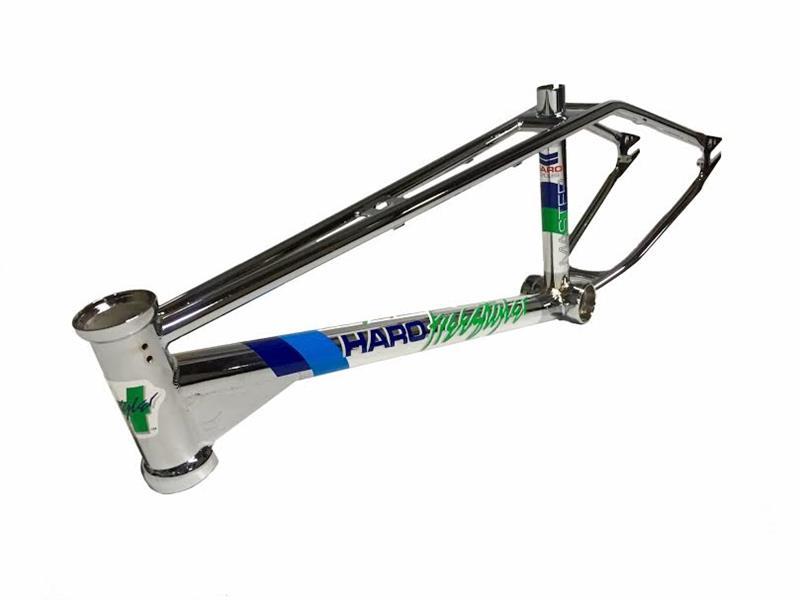
Click Here to Check Best Price
One of the more expensive frames I have investigated and looked into is the Haro Master Flatland Frame. With its’ modern construction and retro styling, this frame can fit the new and old riders. Haro took the 1987 master frame and re-designed it recently to comply with the needs of modern riders.
As you can see from the image of the frame just behind the seat post the rear triangle extends horizontally a little further than normal. Unfortunately, I don’t quite understand why Haro have included this extended top tube but if you know why then give us a comment below.
Haro Master Specifications:
- 100% 4130 chromoly construction with heat treated HT/BB/DO/CS
- Integrated HT with hour glass Mid BB shell and tapered chain stays
- 8mm investment cast Lineage dropouts with integrated axle tensioner hardware
- Twin top tube, butted down tube and externally CNC machined seat tube
- Geometry – 11.5″ BB, 13.75″ RC, 75 HT angle, 71 ST angle, 9″ SO
- 5.5 lbs
KHE Bikes Prism Alloy Flatland Pegs
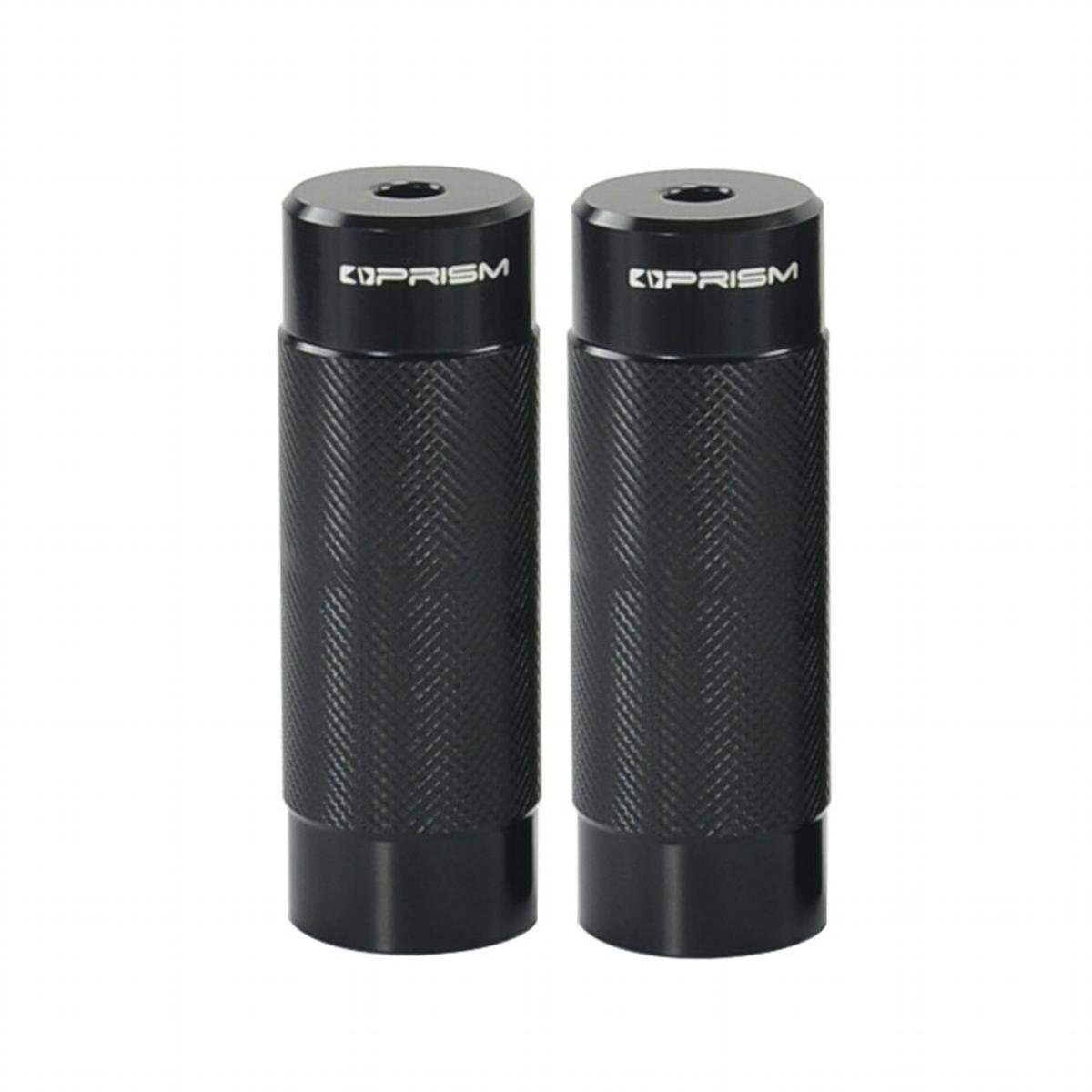
These are the KHE Prism Flatland pegs. It’s not incredibly important to purchase specially designed flatland pegs for flatland BMX riding. If you are looking for new pegs though, these specially designed Prism alloy pegs from KHE are a great way to go. Made out of lightweight aluminium for a 10 mm axle. As you can also see from the image above, the pegs have a very rough section in the middle, making them perfect for foot placement instead of sliding along a rail or ledge.
Flatland BMX Frequently Asked Questions
What are the key historical milestones in Flatland BMX?
Flatland BMX has a rich history marked by key individuals and events. The sport’s evolution was significantly influenced by figures like R. L. Osborn, Bob Haro, and Bob Morales. Key milestones include the formation of the first freestyle BMX team and innovations in bike design and tricks, which have shaped the sport into what it is today.
How do Flatland BMX competitions differ from other BMX competitions?
Flatland BMX competitions are unique in their format and criteria for judging. Unlike park or street competitions, they do not involve obstacles. Instead, riders perform on flat concrete surfaces, and judges assess skills based on the number and difficulty of tricks, coordination, balance, style, flow, and showmanship.
What are the distinctive features of a Flatland BMX bike compared to regular BMX bikes?
Flatland BMX bikes are designed with specific features to aid performance in this discipline. These include shorter wheelbases for easier pedaling and spinning, four pegs for more control, unique parts like freecoasters and gyros for specific tricks, zero offset handlebars, narrow bars, and high-pressure tires.
What role do brakes play in Flatland BMX riding?
In Flatland BMX, brakes are used differently than in other BMX styles. Some riders use both front and back brakes for greater control in performing tricks, while others choose to ride without brakes to challenge their skills further. The use of brakes in Flatland BMX largely depends on the rider’s style and preference.


